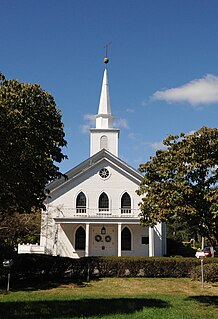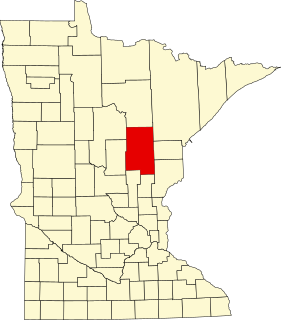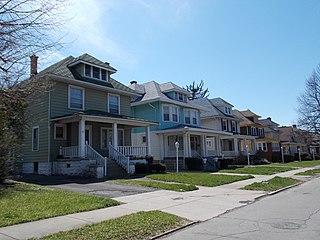Dansville is a village in the town of North Dansville, with a small northern part in the town of Sparta in Livingston County, in western New York, United States. As of the 2020 census, the village population was 4,433. The village is named after Daniel Faulkner, an early European-American settler. Interstate 390 passes the west side of the village.
Groveland is a town in Livingston County, New York, United States. The population was 3,249 at the 2010 census. The town is centrally located in the county, south of Geneseo.

Saint Paul's Evangelical Lutheran Church is a congregation of the Lutheran Church–Missouri Synod (LCMS) located at the intersection of Barr and Madison Streets in Fort Wayne, Indiana. Founded in 1837, it is the second oldest Lutheran church in Indiana and the oldest in the northern part of the state. Thanks largely to its size and to the leadership of its pastors, it has long played a prominent role in Indiana Lutheranism and in the Missouri Synod as a whole.

The Historic Trinity Lutheran Church is a church located in downtown Detroit, Michigan. It occupies the Trinity Evangelical Lutheran Church complex, located at 1345 Gratiot Avenue. It was designated a Michigan State Historic Site in 1981 and listed on the National Register of Historic Places in 1983. Its current pastor is Rev. Darryl L. Andrzejewski.

The Gethsemane Evangelical Lutheran Church is a church located at 4461 Twenty-Eighth Street in Detroit, Michigan. It was designated a Michigan State Historic Site in 1980 and listed on the National Register of Historic Places in 1982. The building now houses the Motor City Missionary Baptist Church.

St. Andrew's Evangelical Lutheran Church Complex, also known as Deliverance Temple of God & Christ, is a historic Evangelical Lutheran church complex located at Buffalo in Erie County, New York. The complex consists of the original German Lutheran church structure constructed in 1859 and later remodeled into a school; the eclectic Gothic-Romanesque style church structure constructed in 1885; and the Queen Anne style parish house constructed in 1892.

Dansville Library is a historic library located at Dansville in Livingston County, New York. It is a large two story Neoclassical style frame structure. It is dramatically enhanced by a pedimented, giant portico covering its full width. The portico features four Doric columns, an elaborate frieze with triglyphs and rosettes, a modillion cornice, and a semi-elliptical fan decoration in the cornice. The earliest section was built in 1823 as a private home for Joshua Shepard (1780–1829). The Shepard family donated the house for use as a library in 1923.

German Evangelical Lutheran Church of St. Mark is a historic church and synagogue building at 323 East 6th Street between First and Second Avenues in the East Village neighborhood of Manhattan, New York City. The Renaissance Revival style church was built in 1847 by the Evangelical Lutheran Church of St. Matthew which first rented it to St. Mark's and subsequently sold it to them in 1857. By the end of the nineteenth century the congregation was in decline as congregants were moving elsewhere. Much of the church membership was killed in the 1904 General Slocum disaster, most of the victims being women and children, and the congregation never recovered.

Zion-St. Mark's Evangelical Lutheran Church, formerly known as Deutsche Evangelische Kirche von Yorkville and Zion Lutheran Church, is a historic Lutheran church at 339-341 East 84th Street in Yorkville, Manhattan, New York City. The congregation is a member of the Evangelical Lutheran Church in America.

Christ Evangelical English Lutheran Church, also known as Rugged Cross Baptist Church, is a historic Evangelical Lutheran church at 1084 Lafayette Avenue, 11221, in Bedford-Stuyvesant, Brooklyn, New York, New York. It was built in 1898–1899 in the Romanesque Revival style. It is faced in cream colored brick with beige brick and terra cotta trim. The front facade is arranged with a two story tall central gable flanked by asymmetrical towers.

Church of the Holy Innocents is a historic Roman Catholic parish church in the Diocese of Brooklyn located at 279 E. 17th St. in Flatbush, Brooklyn, New York, New York. The church was built in 1923 in the Late Gothic Revival style. It is built of granite with limestone trim. It consists of a tall, clerestoried nave with gable roof, lower flat-roofed side aisles, transepts, chancel, and a tall bell tower. Attached to the church is a rectory (1923) and school (1914).

Gallupville Evangelical Lutheran Church is a historic Evangelical Lutheran church on 980 NY 443 in Gallupville, Schoharie County, New York. It is a rectangular, gable roofed, timber framed structure with narrow clapboard siding in the vernacular Greek Revival style. It was built in 1853 and a two bay, gable roofed Sunday School parish wing was added about 1964. A large two floor parish hall was added about 2002 that includes classrooms, offices, youth room, nursery, library, food pantry and storage areas.

Palatine Church, also known as Palatine Evangelical Lutheran Church, is a historic Evangelical Lutheran church on Mohawk Turnpike in Palatine, Montgomery County, New York. It was built in 1770 and is a small, rectangular, one story structure with massive stone walls. It features a traditional meetinghouse plan.

Evangelical Lutheran Church of Saddle River and Ramapough Building is a historic church at 96 E. Allendale Road in Saddle River, Bergen County, New Jersey, United States.

This is a list of the National Register of Historic Places listings in Aitkin County, Minnesota.

St. John's Evangelical Lutheran Church is a congregation of the Evangelical Lutheran Church in America in Passaic, Passaic County, New Jersey, United States. It is noted for its historic church at 140 Lexington Avenue, which was built in 1896 and added to the National Register of Historic Places in 1982.

George Willard Conable (1866-1933), AIA, was an American architect practicing in New York City in the early to mid 20th century specializing in churches.

Zion Lutheran Church, also known as the Zion Church of the City of Baltimore, is a historic Evangelical Lutheran church located in downtown Baltimore, Maryland, United States, founded 1755.

Swedish Evangelical Lutheran Church, now known as Swedesburg Evangelical Lutheran Church, is a historic church located in Swedesburg, Iowa, United States. The congregation was officially organized in 1866 by the Swedish Lutheran congregation from New Sweden in Jefferson County, Iowa. The present church was built in 1928 as the third church to stand on the same site. The first frame church, built in 1868, was destroyed in a fire in 1883. The second frame church, with a 110-foot (34 m) tower, was completed the same year. In 1927 it too was also destroyed by fire. The congregation hired Burlington, Iowa architect W.F. Weibley to design the present Late Gothic Revival church building. It is composed of tan brick with Bedford stone trim. The church was added to the National Register of Historic Places in 1999.

Hamlin Park Historic District is a national historic district and neighborhood located at Buffalo in Erie County, New York. The district encompasses 1,368 contributing buildings, 3 contributing sites, and 6 contributing structures in a predominantly residential section of Buffalo. The district includes a variety of residential buildings built primarily between about 1895 and 1930, and later improved through Model Cities Program grants between 1966 and 1975. It includes a variety of pattern book houses in popular architectural styles of the late-19th and early-20th century, with some interspersed Bungalow / American Craftsman style dwellings. Located in the district are the separately listed Robert T. Coles House and Studio and Stone Farmhouse. Other notable buildings include the Lutheran Church Home (1906), the former Second United Presbyterian Church (1920), and the former St. Francis DeSales Roman Catholic Church (1926).






















